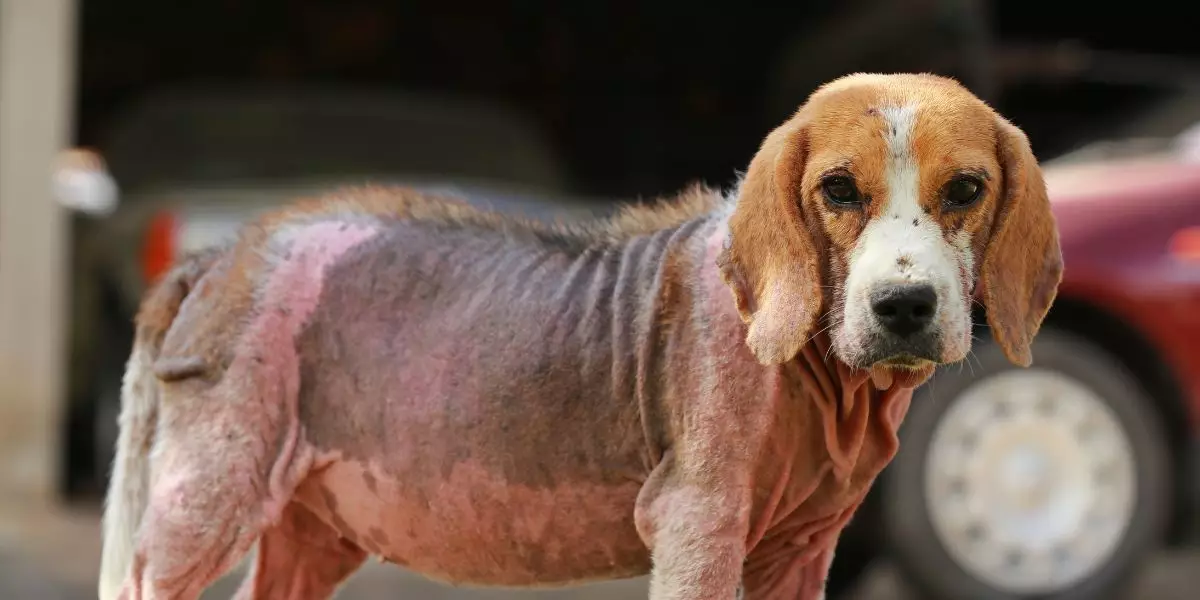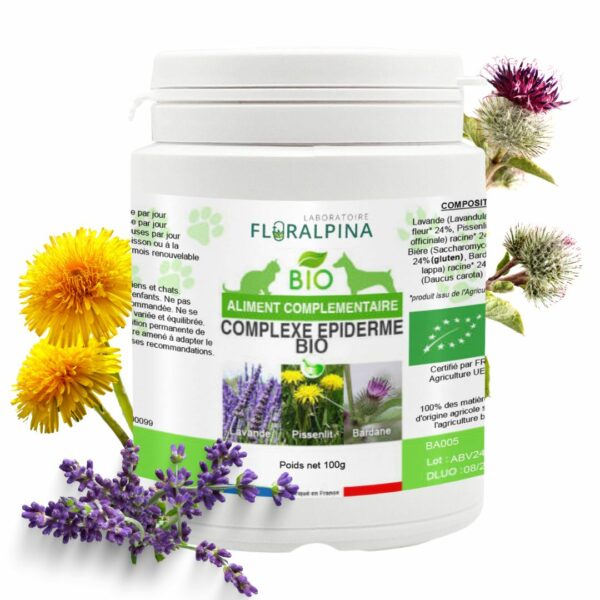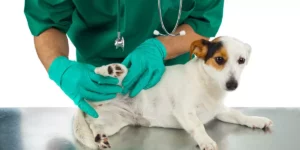Table of Contents
ToggleWhat is sarcoptic scab in the dog?
The scab in the dog is a parasitic skin infection caused by a mite called Sarcoptes scabiei. The latter settles in the dog's skin and lays eggs. Transmission is most often done by contact direct between dogs, but also via the contaminated environment.
The infected dog will then feel strong itching, redness will appear on his body as well as small bumps on the skin and he will begin to loss of hair by area. The most affected areas are often ears, neck, armpits and belly, but the whole body surface can be affected. Be careful not to confuse scabies with pyodermitis, which is another skin disease caused by a bacterium this time. We have also written an article on this subject: Pyodermitis in dogs.
Diagnosis is done by examining skin scrapes under microscope to observe the presence of mites, their eggs or their characteristic excrement. Serological tests are also available.
Treatment is based on the use of antiparasitic tablets, topical drops or medicinal shampoos. Several successive treatments are generally required. The environment must also be decontaminated. To prevent infestation, it is recommended to treat your dog regularly with pest control agents and avoid contact with infected dogs. Early diagnosis and treatment are important to limit contagion.
How do I know if a dog with a scab? What are the symptoms of scabies?
Here are the main signs that a dog has a scab:
-
- Severe itching This is often the first symptom observable. The dog scratches, licks or rubs too much.
-
- Hair loss zones : following scratches, the dog may have localized areas of hair loss (often on the belly, ears, legs, snout). Excessive hair loss may also be due to the moulting of your animal. For more information, see our article on dog moulting.
-
- Redness, buttons, crusts : The skin has inflammatory lesions of the type papules, vesicles, pustules or can become thickened with appearance of crusts.
-
- Skin thickened areas Over time, the affected skin can become thickened, injured, and get rough.
-
- Nausea smell : an unpleasant smell sometimes emanates from the skin in case of severe scabies.
-
- Film : significant desquamation leads to the formation of film.
-
- Agitation : the dog can be agitated, nervous, not fit due to itching.
If these signs are present, it is recommended to consult a veterinarian. The latter can make a definitive diagnosis by examining skin scrapes under the microscope. It will then determine the appropriate pest control treatment to treat and relieve your dog.
How to treat scabies in dogs?
To treat scabies in dogs, you must follow several steps:
-
- Consult a veterinarian: It is essential to have the scab diagnosed by a veterinarian, via a parasitological examination of skin scrapings. This will allow the veterinarian to prescribe the appropriate pest control treatment.
-
- Apply a pest control treatment: Treatment is usually based on pest control drugs in the form of tablets, solutions or shampoos to be applied to the skin. It is imperative to follow the prescribed dosage and duration of treatment to effectively eliminate sarcopts.
-
- Insulate the dog during treatment: To avoid contagion to other dogs or humans, it is recommended to isolate the infected dog during treatment.
-
- Disinfect the environment : Since sarcopters can survive for some time in the environment, it is important to wash blankets, baskets and disinfect soil and surfaces with acaricide products.
-
- Treat other dogs : If the affected dog lives with other dogs, it is preferable to treat them preventively against sarcopts with the medicines prescribed by the veterinarian.
-
- Monitor evolution : Although itching decreases rapidly, continued treatment to the end is essential to eliminate all parasitic forms. Parasitological examination can confirm healing.
With rigorous treatment, the scab heals well in the dog. However, recurrences are common if the environment is not well disinfected. Prevention therefore remains a priority.
Dog's ears
Ear scab, or otodecticosis, is a parasitic infection of the dog's ears caused by a microscopic carian, Otodectes cynotis. It feeds on cerumen and desquamation present in the dog's auditory duct. He will then cause:
-
- Severe itching in the ears
-
- Common shaking of the head
-
- Redness at the entrance of the hearing canal
-
- Presence of dark debris and cerumen in the duct
-
- Flammation
-
- Formation of crusts or lesions
Transmission occurs through direct contact between animals or through a contaminated environment (e.g. litter). Immunocompromised puppies and dogs are more sensitive. To diagnose the scab of the ears, mites and their eggs must be observed under the microscope from a cerumen sample in the ear.
Be careful, however, not to confuse the scab of the ears with the eczema of the ears of the dog. We made an article about this: Dog eczema, ears.
The treatment of the ear scab is the same as for scabies on another part of the body. We'll detail this in the next section.
Natural treatment for scabby ears
There are some natural treatments that can relieve ear scabies in dogs, even if consultation with a veterinarian is recommended. Here are some natural remedies that can be used:
Essential oils Oils such as tea tree, lavender, geranium or peppermint can relieve itching and have a pest control effect. To be diluted in vegetable oil before application or spraying in the ear.
Cider vinegar : slightly acidic, vinegar allows to change the pH of the ear to stop mites proliferation. To be used diluted in lotion water.
Garlic and onion : crushed and pressed, they release sulphur compounds insecticides. To be inserted into the ear as juice.
Gel of aloe vera : anti-inflammatory and natural healing, it calms itching. To be applied locally on and in the ear.
Coconut or olive oil : have moisturizing, calming and protective properties of the skin. Use warm massages around the ear.
Rather, these remedies are intended to relieve symptoms while waiting to deal with the substance of the problem. They are not recommended for open wounds. And if symptoms persist, the veterinarian remains the resort.
Our food supplement against dog skin problems
At Veto Companion, we formulated a herbal food supplement to help fight skin problems in dogs, it is the epidermis complex.
Organic Epidermis Complex
The 100g organic epidermal complex is a 100% natural, oversaturated plant-based solution that will protect and purify your animal's skin. ✅Cleans skin ✅Reduce itching ✅Helps fight eczema Format: 100g Dose spoon included
F.A.Q.
Does the dog's scab pass to man?
Yes, the dog's scab can be passed on to man in some cases and cause very pruriginous skin affliction. However, it should be noted that direct transmission from the dog's scab to the man is rather rare. Indeed, it can only take place by direct skin contact between human skin and an infected dog. The sarcopt (Sarcoptes scabiei canis) must come into contact with human skin to attach and develop.
Symptoms occur only after 4 to 6 weeks of incubation, in exposed skin areas (between fingers, wrists, elbows...). Itchings are very intense, sometimes with a rash of small blisters. The diagnosis is confirmed by a parasitological examination of the lesions to identify the presence of the parasite.Local or oral pest control treatment helps to overcome this scab transmitted from dog to man within a few weeks in most cases. Although uncommon, this zoonose can affect dog owners, veterinarians, animal workers... where the importance of taking special precautions with an infected animal.






